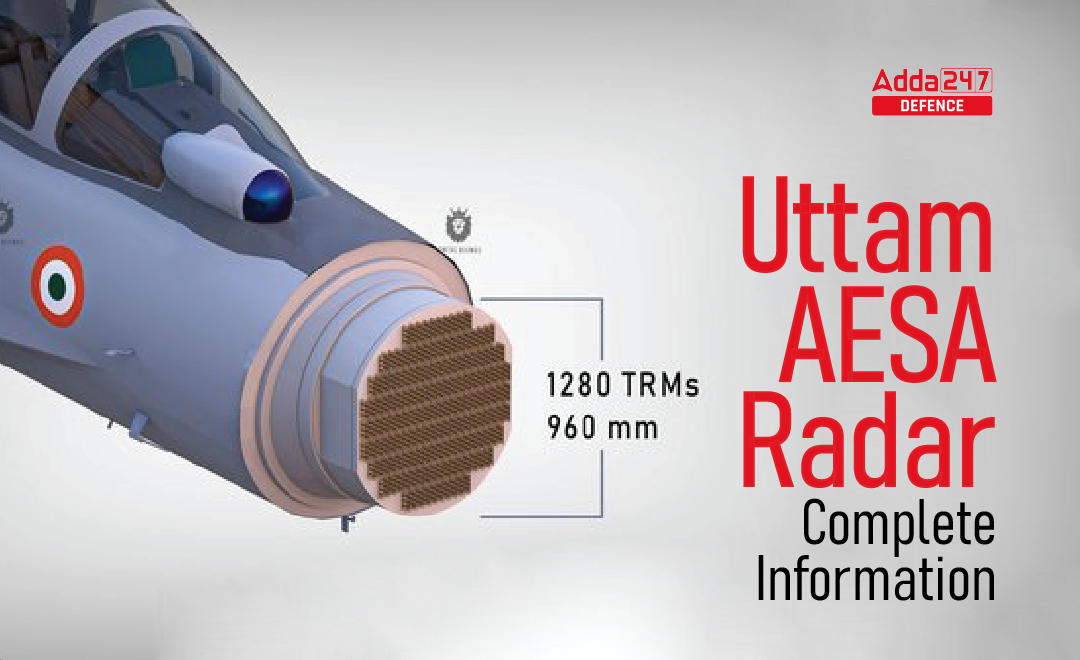Uttam AESA Radar
Uttam AESA stands for Uttam Active Electronically Scanned Array (AESA) radar developed by the Electronics & Radar Development Establishment (LRDE) which is an establishment of DRDO.
It will help to bolster the strength of the Indian Air Force (IAF) as the main objective of it is to be installed in LCA Tejas Mk1A, Tejas Mk2, AMCA, and TEDBF fighter jets. Modern Aircraft and also the Naval Vessels are equipped with AESA Radar.
IAF also intends to equip the Su-30 Mki and MiG 29 UPG with this AESA Radar.
With the completion of more than 100 hours of flying on a hired aircraft and nearly 25 hours on Tejas, It is now confirmed that Uttam’s air-to-air mode and its sub-mode functionalities have been already tested.
Uttam is in competition with the Israeli Elta radar and it’s still not officially revealed that how many Tejas MK1As (a total 83) will be equipped with this indigenous technology.
Radar
Radar stands for Radio Detection and Ranging. In Radar, the transmitter sends a pulse signal in the air, and this pulse signal gets reflected back after striking the object. And then the object is located using the time difference between the transmission and reflection.
Uttam Radar
The Uttam is an advanced active phased array radar (APAR) system being developed by the Electronics and Radar Development Establishment (LRDE) for the HAL Tejas and other combat aircraft of the Indian Air Force.
AESA radar is an array antenna controlled by a computer. In AESA, each antenna element is connected to TRM (Transmitter/Receiver Module) independently. This complicated module of AESA allows the radar to emit multiple radio waves at multiple frequencies simultaneously. The beam of radio waves can be electronically steered to point in different directions without moving the antenna.
Manufacturing of Uttam was started in 2008 and it was unveiled at Aero India 2009 for the very first time. It is considered to be a successor to the hybrid passive electronically scanned array radar EL/M-2032 currently equipping LCA Tejas. Radar is currently being integrated with an LCA.
Difference Between AESA and PESA Radar:
- Traditional passive phased array radars have a single high-power RF source (usually Travelling Wave Tube) at ‘back-end’ and RF signals are fed into a slotted array antenna via a waveguide or coaxial tube. PESA radar uses common shared RF source in which signal is modified using digitally controlled phase shifter modules.Following are the features of PESA radar.
• It uses a single transmitter/receiver module.
• PESA radar produces a beam of radio waves which can be electronically steered in different directions.
• Here antenna elements are interfaced with a single transmitter/receiver. Here PESA differs from AESA where separate transmit/receive modules are used for each of the antenna elements. All these are controlled by the computer as mentioned below.
• Due to the single frequency of use, it has a high probability to be jammed by enemy RF jammers.
• It has a slow scan rate and can track only a single target or handle a single task at a time.
Active phased array antennas have transmitter-receiver modules or transceiver modules (TRM) built right into the antenna. AESA uses an electronically controlled array of antennae in which a beam of radio waves can be electronically steered in order to point the same in different directions without movement of the antenna. It is considered to be an advanced version of PESA radar.AESA uses many individuals and small transmit/receive modules.
Following are the features of AESA radar
• It uses multiple transmitter/receiver modules.
• The multiple Transmit/Receive modules are interfaced with multiple antenna elements known as array antennae.
• AESA radar produces multiple beams at different radio frequencies simultaneously.
• Due to the capabilities of multiple frequency generation over a wide range, it has the least probability to be jammed by enemy RF jammers.
• It has fast scan rates and can track multiple targets or multiple tasks.
Characteristics of Uttam AESA Radar:
- UTTAM has capabilities like Identification friend or foe (IFF), electronic and communication support measures, C-band line-of-sight and Ku-band SATCOM datalinks, High ECM (Electronic Counter Measures) immunity, High-Resolution Imaging, Weather tracking, Doppler Beam Sharpening etc., similar to those on the AWACS and Conformal Airborne Early Warning & Control Systems (CAEW) systems.
- The important modes of operation of the UTTAM radar system are the surface surveillance and the air surveillance. The sensor has the ability to search, track-while-scan, prioritise tracking, high-performance tracking, etc. Utilizing active aperture technology, the radar provides a fast-beam agile system that can operate in several modes concurrently.
- Uttam features an active phased array (APAR) which gives it superior scanning performance over legacy passive phased array radar. Unlike most contemporary radars, Uttam features Quad TRM i.e. a single plank consisting of 4 TRMs. It allows the array to be more densely packed. Each TRM is equipped with a low noise power amplifier, built-in test facility, digital phase gain, and side lobe control elements. The QTRM configuration makes Uttam maintenance friendly. The radar can be scaled up or down depending on antenna size requirements.
- The radar is capable of tracking 100 targets simultaneously and engaging 6 of them by SARH/ARH missiles in high-priority tracking mode. For example, Elta EL/M-2052 is capable of tracking 64 targets in TWS mode.



 AOC Result 2025 Out, Download Link Activ...
AOC Result 2025 Out, Download Link Activ...
 CISF Constable Tradesmen Recruitment 202...
CISF Constable Tradesmen Recruitment 202...
 How to Join NSG After 12th?
How to Join NSG After 12th?
